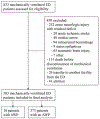The ED-AWARENESS Study: A Prospective, Observational Cohort Study of Awareness With Paralysis in Mechanically Ventilated Patients Admitted From the Emergency Department
- PMID: 33485698
- PMCID: PMC8166299
- DOI: 10.1016/j.annemergmed.2020.10.012
The ED-AWARENESS Study: A Prospective, Observational Cohort Study of Awareness With Paralysis in Mechanically Ventilated Patients Admitted From the Emergency Department
Abstract
Study objective: Awareness with paralysis is a devastating complication for patients receiving mechanical ventilation and risks long-term psychological morbidity. Data from the emergency department (ED) demonstrate a high rate of longer-acting neuromuscular blocking agent use, delayed analgosedation, and a lack of sedation depth monitoring. These practices are discordant with recommendations for preventing awareness with paralysis. Despite this, awareness with paralysis has not been rigorously studied in the ED population. Our objective is to assess the prevalence of awareness with paralysis in ED patients receiving mechanical ventilation.
Methods: This was a single-center, prospective, observational cohort study on 383 mechanically ventilated ED patients. After extubation, we assessed patients for awareness with paralysis by using the modified Brice questionnaire. Three expert reviewers independently adjudicated awareness with paralysis. We report the prevalence of awareness with paralysis (primary outcome); the secondary outcome was perceived threat, a mediator for development of posttraumatic stress disorder.
Results: The prevalence of awareness with paralysis was 2.6% (10/383). Exposure to rocuronium at any point in the ED was significantly different between patients who experienced awareness with paralysis (70%) versus the rest of the cohort (31.4%) (unadjusted odds ratio 5.1; 95% confidence interval 1.30 to 20.1). Patients experiencing awareness with paralysis had higher mean values on the threat perception scale, denoting a higher degree of perceived threat, compared with patients who did not experience awareness with paralysis (13.4 [SD 7.7] versus 8.5 [SD 6.2]; mean difference 4.9; 95% confidence interval 0.94 to 8.8).
Conclusion: Awareness with paralysis occurs in a significant minority of ED patients who receive mechanical ventilation. Potential associations of awareness with paralysis with ED care and increased perceived threat warrant further evaluation.
Copyright © 2020 American College of Emergency Physicians. Published by Elsevier Inc. All rights reserved.
Conflict of interest statement
Conflicts of Interest
None.
Figures
Comment in
-
Speechless: Awareness With Recall of Paralysis in the Emergency Department Setting.Ann Emerg Med. 2021 May;77(5):545-546. doi: 10.1016/j.annemergmed.2020.11.006. Epub 2021 Jan 13. Ann Emerg Med. 2021. PMID: 33454139 No abstract available.
References
-
- Cook TM, Andrade J, Bogod DG, et al. 5th National Audit Project (NAP5) on accidental awareness during general anaesthesia: patient experiences, human factors, sedation, consent, and medicolegal issues. British Journal of Anaesthesia. 2014;113(4):560–574. - PubMed
-
- Pandit JJ, Andrade J, Bogod DG, et al. 5th National Audit Project (NAP5) on accidental awareness during general anaesthesia: summary of main findings and risk factors. British Journal of Anaesthesia. 2014;113(4):549–559. - PubMed
-
- Avidan MS, Mashour GA. Prevention of intraoperative awareness with explicit recall: making sense of the evidence. Anesthesiology. 2013;118(2):449–456. - PubMed
-
- Leslie K, Chan MTV, Myles PS, Forbes A, McCulloch TJ. Posttraumatic stress disorder in aware patients from the B-aware trial. Anesthesia and Analgesia. 2010;110(3):823–828. - PubMed
-
- Sandin RH, Enlund G, Samuelsson P, Lennmarken C. Awareness during anaesthesia: a prospective case study. Lancet. 2000;355(9205):707–711. - PubMed
Publication types
MeSH terms
Grants and funding
LinkOut - more resources
Full Text Sources
Other Literature Sources
Medical


